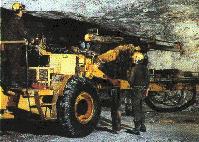Mining in Manitoba
Bernic Lake Mining Area
History of the Bernic Lake Area
Spodumene (a lithium ore), tantalum and cesium have been produced from the Bernic Lake pegmatite, in the Bird River greenstone belt, 60 km east of Lac du Bonnet. The pegmatite has been developed by a shallow mine, accessed by a 20-degree decline. The mine utilizes a room-and-pillar method. Tantalum occurs in a variety of mineralized zones. Cesium occurs with the spodumene, lepidolite, and feldspars. Two lepidolite zones contain lithium, tantalum, rubidium and gallium. Over 60 trace and rare minerals have so far been identified in this pegmatite.
Explored for tim in the late 1920's, interest in the pegmatite was renewed between 1954 to 1957, this time for lithium. From 1962 to 1967 cesium ore was mined. This pegmatite is believed to hold the world's largest reserves of cesium.

In 1966, new markets in the electronic components and the tool-die industries emerged for the tantalite. Plant work began in 1967 and production reached 450 tpd. Plant capacity was increased to 680 tpd in 1974. Production ceased in 1982 due to declining markets and falling prices.
The Tanco operation is owned by Cabot Berylco Industries Ltd, Manitoba Mineral Resources, and Hudson Bay Mining & Smelting Co. Ltd. In 1986, a new plant to produce ceramic grade spodumene was built.